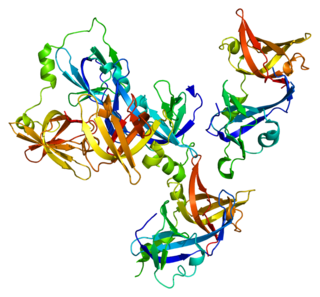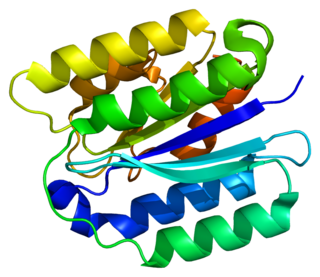
Bone morphogenetic protein 10 (BMP10) is a protein that in humans is encoded by the BMP10 gene.

G-protein coupled receptor 4 is a protein that in humans is encoded by the GPR4 gene.

Lysophosphatidic acid receptor 2 also known as LPA2 is a protein that in humans is encoded by the LPAR2 gene. LPA2 is a G protein-coupled receptor that binds the lipid signaling molecule lysophosphatidic acid (LPA).

Chemokine-binding protein 2 is a protein that in humans is encoded by the CCBP2 gene.

Gamma-interferon-inducible protein Ifi-16 (Ifi-16) also known as interferon-inducible myeloid differentiation transcriptional activator is a protein that in humans is encoded by the IFI16 gene.

Anthrax toxin receptor 2 is a protein that in humans is encoded by the ANTXR2 gene.

60S ribosomal protein L23 is a protein that in humans is encoded by the RPL23 gene.

Serine/threonine-protein kinase PLK2 is an enzyme that in humans is encoded by the PLK2 gene.

Cdc42 effector protein 1 is a protein that in humans is encoded by the CDC42EP1 gene.

Porimin is a protein that in humans is encoded by the TMEM123 gene.

Angiopoietin-4 is a protein that in humans is encoded by the ANGPT4 gene.

Putative quinone oxidoreductase is an enzyme that in humans is encoded by the TP53I3 gene.

C-type lectin domain family 1 member B is a protein that in humans is encoded by the CLEC1B gene.

Endosialin is a protein that in humans is encoded by the CD248 gene.

P2X purinoceptor 6 is a protein that in humans is encoded by the P2RX6 gene.

Eukaryotic translation elongation factor 1 epsilon-1 is a protein that in humans is encoded by the EEF1E1 gene.

Nuclear factor related to kappa-B-binding protein is a protein that in humans is encoded by the NFRKB gene.

B-cell receptor-associated protein 29 is a protein that in humans is encoded by the BCAP29 gene.

Plexin domain-containing protein 1 is a protein that in humans is encoded by the PLXDC1 gene.

Plexin domain-containing protein 2 is a protein that in humans is encoded by the PLXDC2 gene.



















